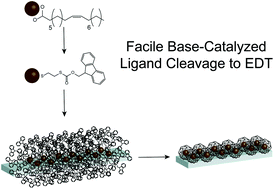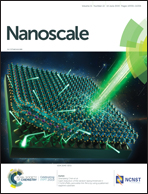Ligand cleavage enables formation of 1,2-ethanedithiol capped colloidal quantum dot solids†
Abstract
Colloidal quantum dots have garnered significant interest in optoelectronics, particularly in quantum dot solar cells (QDSCs). Here we report QDSCs fabricated using a ligand that is modified, following film formation, such that it becomes an efficient hole transport layer. The ligand, O-((9H-fluoren-9-yl)methyl) S-(2-mercaptoethyl) carbonothioate (FMT), contains the surface ligand 1,2-ethanedithiol (EDT) protected at one end using fluorenylmethyloxycarbonyl (Fmoc). The strategy enables deprotection following colloidal deposition, producing films containing quantum dots whose surfaces are more thoroughly covered with the remaining EDT molecules. To compare fabrication methods, we deposited CQDs onto the active layer: in one case, the traditional EDT-PbS/EDT-PbS is used, while in the other EDT-PbS/FMT-PbS is used. The devices based on the new EDT/FMT match the PCE values of EDT/EDT controls, and maintain a higher PCE over an 18 day storage interval, a finding we attribute to an increased thiol coverage using the FMT protocol.



 Please wait while we load your content...
Please wait while we load your content...